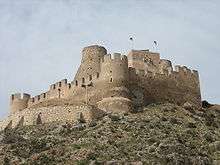Biar
The small town of Biar, with its monumental Arabic castle, is one of the better-preserved medieval towns in Alicante (province) and in the Valencian Community.
Understand
The name is likely derived from the Arabic word بِئَار (bi'ar – 'well'). The town has been inhabited since prehistoric times, although the current town layout dates primarily from the Moorish period. After the Christian reconquista in the 13th century the town and castle became a border post along the frontier between the kingdoms of Castile and of Aragon and Valencia.
Today the town's economy is primarily based on the production of olive oil, with a secondary focus on tourism.
- 🌍 Tourist Info, Calle Cura Reig, 1, ☎ +34 965 811 177, e-mail: biar@touristinfo.net. Tu-Sa 08:30-14:30, holidays 09:00-14:00.
Get in
By car
The most convenient way to get to Biar is definitely by car.
By public transport
Getting in by public transport is possible, but requires some careful planning. To and from Villena Subus runs one bus a day Monday through Friday. The bus departing Villena leaves at the very inconvenient time of 06:10, but there is a taxi stand just outside the Villena train station, and the ten minute journey by taxi from Villena to Biar will cost about €15. The return bus leaves Biar at approximately 15:45 and arrives at Villena 15 minutes later. A current bus schedule can be downloaded here.
Get around
It is easiest to get around by food, as Biar is very small.
See

- 🌍 Castell de Biar (Castillo de Biar / Castle of Biar), ☎ +34 657 912 407. Mid-Sep to Jun: Tu 10:15-13:45, W-F 10:15-13:45 16:15-19:15, Sa Su 11:00-15:00. Initially built in the 12th century by the Moors, the castle was conquered by King Jaime of Aragon and eventually marked the border between the kingdoms of Castile and Aragon. The central tower is the oldest part of the fortification, and was constructed of masonry and rammed earth. Especially noteworthy is the Almohad ribbed dome on the tower's second floor, which is one of the oldest domes of its type in Spain and the only one used in a fortress. The outer walls were added in the 15th century. €1.
- 🌍 Museu Etnogràfic Municipal (Museo Etnográfico Municipal / Municipal Ethnographic Museum), Carrer Major, 1, ☎ +34 965 812 029. Mid-Sep-Jun: Tu 16:15-19:15, W-Sa 10:15-13:45 16:15-19:15, Su 10:15-13:45. The 19th-century building houses a collection of regional historic and cultural artifacts, with a focus on ceramics. €1.
Do
- Moros i Cristians (Moros y Cristianos / Moors and Christians). 10-13 May. Biar celebrates the Christian reconquista like many other towns in the area, complete with mock battles and bonfires.
Buy
- 🌍 Cerámica Artística Maestre, Camino de la Virgen, 28, ☎ +34 965 810 062, e-mail: info@ceramicaMaestre.com. M-F 10:00-13:00 16:00-20:00, Sa Su 11:00-14:00; best to call ahead. Ceramics have been manufactured in the town since the Moorish period. This workshop, founded in the late 19th century by a ceramics master from Manises, produces handmade and limited edition pieces using traditional white and blue patterns characteristic of Biar. Tours of the facility can be arranged by request.
- 🌍 Mercadillo, Av del País Valencià. W mornings. The weekly street market is good for picking up fresh produce and various odds and ends.
Eat
- 🌍 Pizzeria-Restaurante Chao Chao, Carrer Pare Arnau, 18, ☎ +34 965 810 697. Tu-Sa 12:00-00:30, Su 12:00-24:00. A well-established pizzeria/tapas bar.
Drink
Sleep
- 🌍 Hotel Mas Fontanelles, Ctra Biar-Bañeres, km 4, ☎ +34 686 426 126. Check-in: 13:00, check-out: 12:00. The casa rural has an outdoor pool, onsite restaurant, and free Wi-Fi. Doubles €70+, including breakfast.
- 🌍 Hotel Rural Castillo de Biar, Ctra Biar-Bañeres, s/n, ☎ +34 965 810 612, e-mail: info@hotelruralcastillodebiar.es. Check-in: 14:00-22:00, check-out: 12:00. The casa rural has an outdoor pool, onsite bar/restaurant, and free Wi-Fi. Pets permitted on request for no extra charge. Single €56, doubles €66.
- 🌍 Hotel Villa de Biar, C/ San José, 2 (centre of town), ☎ +34 965 812 021, e-mail: vdebiar@hotelesposeidon.com. Check-in: 16:00, check-out: 12:00. Completely renovated in 2011, the hotel has an outdoor pool, onsite restaurant, fitness centre, and free Wi-Fi. Pets permitted on request. Doubles €66+.